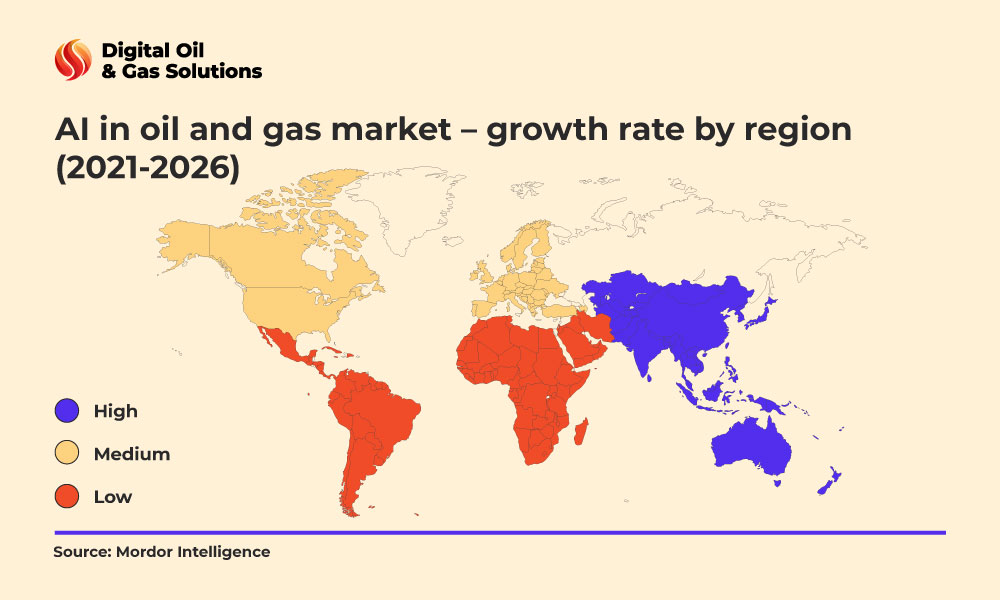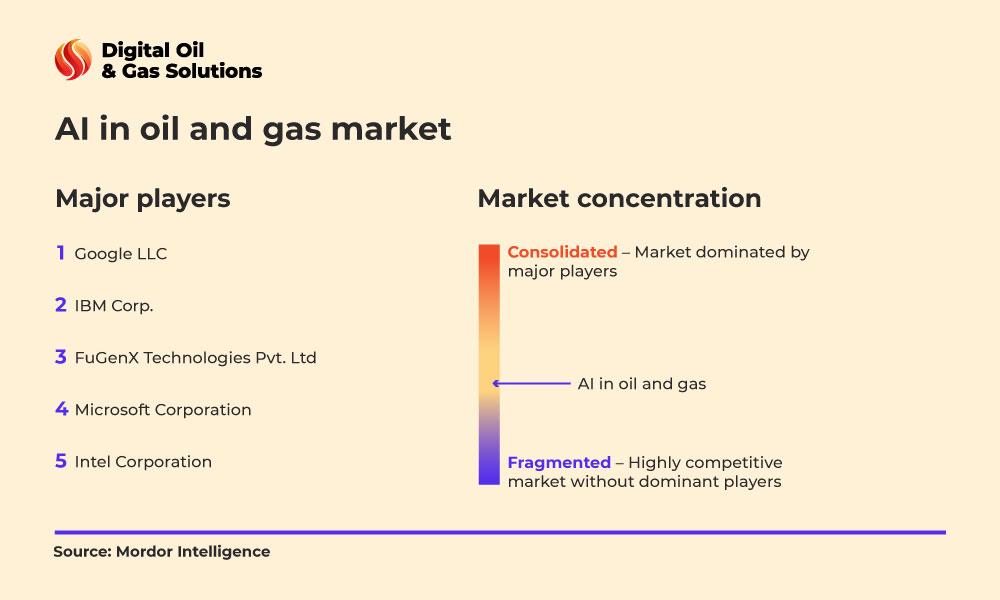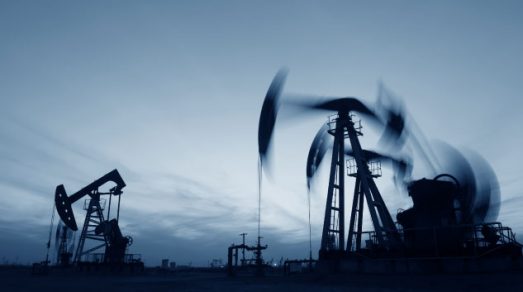The journey towards an improved power industry
Some companies have already started their run towards an intelligent power industry, proving that well-designed AI systems are incredibly beneficial when repetitive and rule-based tasks are automated. This practice allows humans to engage with more worthwhile projects to face tomorrow’s power disturbances. In this context, AI works as a series of methods and technologies that analyze environments and act upon data to carry out specific energy goals. At the same time, ML in oil and gas can prognosticate almost any outcome using data and produce accurate models, presenting outstanding industry benefits.
Therefore, more corporations in the oil and gas sector are exploring these technologies to enhance their efficiency and revenue. We’ll take one of Google’s subsidiaries as an example. At DeepMind, they have applied ML algorithms to 700 megawatts of wind power to predict power output 36 hours ahead of actual generation in the central United States. There’s no doubt that advanced economies lead the way in applying AI and providing better performance, faster problem solving, and improving systems.

The advantages of embracing AI & ML in oil and gas
After facing and still struggling to survive the global pandemic, energy demand starts to recover with the economy’s gradual reopening. As the market faces new challenges, oil and gas producers are rethinking processes and finding efficiencies. Let us explain the top seven advantages of adopting ML and AI software for oil and gas industry.
Data digitation
Although some companies are skeptical about how AI and ML will change the energy industry, it is only a matter of time before adopting these technologies becomes the norm. If we think of all the data that has been accumulated over the years and start using it as practical insights, the entire industry can profit.
With AI and ML, data management and storage can be far more effective. Companies can create algorithms for technologies to collect and structure information, detect certain patterns, and unleash significant findings. At this rate, business leaders can make well-informed decisions faster. Meanwhile, better performance will enhance energy production and distribution, saving time and money.Faultless operations
Drones have become especially useful for fault detection due to their high-resolution and infrared cameras, plus the capacity to reach large geographical areas and rough grounds. For example, the United Kingdom’s National Grid has utilized drones to cover thousands of miles of overhead lines to monitor transmission towers and wires carrying power from the stations to the cities and neighborhoods. AI is then used to process images, discern power assets’ conditions, and decide whether they need replacements or repair.Greener economy
The pressure to convert into a low-carbon economy is urgent, and the challenges of achieving that need to be encountered. We’re transferring from commodity pricing to a market based on technology improvements to integrate renewable energy. As we look forward to the so-called Fourth Industrial Revolution, artificial intelligence has become the source of solutions for grid operators, developers, and consumers. The efforts made are leading the way to a steady transformation with higher use of renewables.Disaster recovery
AI systems can access large amounts of information faster than any human could, providing better estimations and optimizing decision-making when a disaster happens. We’ll take Hurricane Irma as an example. When the disaster happened, it took 10 days to bring back the energy power in Southern Florida. Since AI can predict power availability, it can also ensure its quicker delivery to those places where it is needed most. Previously, when Hurricane Wilma struck, it took 18 days to recover.Prevention of losses
Informal connections are a big challenge for the power sector, and a significant source of losses. AI is applied to find inconsistencies in usage patterns, consumer data, and payment records and detect informal connections. Consequently, it optimizes physical inspections that can be extremely time-consuming.
After experiencing tremendous losses due to a substantial percentage of non-technical issues, Brazil is one of the countries that has been dramatically benefited from implementing AI based solutions. With an algorithm that analyzes power meters and all its data, they were able to detect detailed abnormal usage. Due to this success, the technology is also going to be deployed across Latin America.Predictive analytics
Thanks to ML in oil and gas, AI can prognosticate precise outcomes that are more effective and prolific than humans’ ones. Predictive analytics enables cost cutting, business resilience, power savings, and better customer experience. For example, at Toshiba ESS, to discard any possibilities that might shut down plants, predictive analytics is used to forecast any problems. In general, to reduce risks and increase industry opportunities, neural networks need to analyze old patterns and historical data. These predictions help trade, buy, or sell energy in the stock markets, as ML in oil and gas identifies and foretells significant changes in the production or loss of power.Energy storage optimization
Currently, with the rugged and sensitive nature of renewable power containment, energy storage systems can’t use, concede, or even process large amounts of energy. Here’s where AI and ML can make a prominent difference since their storing energy methods are abundant.
AI in oil and gas industry plays a significant role. Its growing importance is evidence of how the transformation to a vibrant environment with shared resources is reached. AI in oil and gas sector is a powerful tool to optimize energy storage, and it’s becoming a vital technology to improve the ever-evolving energy market.
Trends currently directing the market
Current and upcoming trends show how AI and ML will change the energy industry. Below we list the major market tendencies that we should all be keeping a close eye on:
- More significant technology investments will be taking place to obtain the required level of AI implementation.
- North America is expected to dominate the market with the largest share of AI in oil and gas. The USA and Canada will boost the demand for AI in the region.
- AI will become notably competitive. Although several big players are controlling the market, more companies are willing to broaden their services to expand sales.

A future powered by data
Thinking about a prosperous future, we need to start acting now since the increase of demand for AI in the oil and gas market is inevitable. In fact, its value will go from $2 billion in 2019 to $3.81 billion by 2025. In the future powered by data, the adoption of innovative technology has become a priority for many industries.
ML and AI influence has already proved its efficiency, and early adopters are gaining dominant positions in the market. Although its implementation is imminent, the lack of professionals experienced in AI has become an impediment in the journey. And to achieve the required level of AI adoption, more companies are looking to partner with IT companies to complete the transition faster.
In reality, it’s hard to picture a future where AI is not embraced and failing to do so will leave companies behind. Our knowledge at Digital Oil and Gas Solutions has given us the tools and experience to help several companies address their digital barriers and goals. Contact us and let us answer your questions as we guide you through your transition journey.






